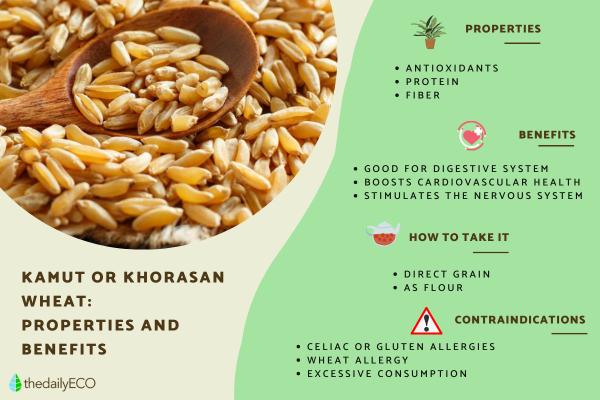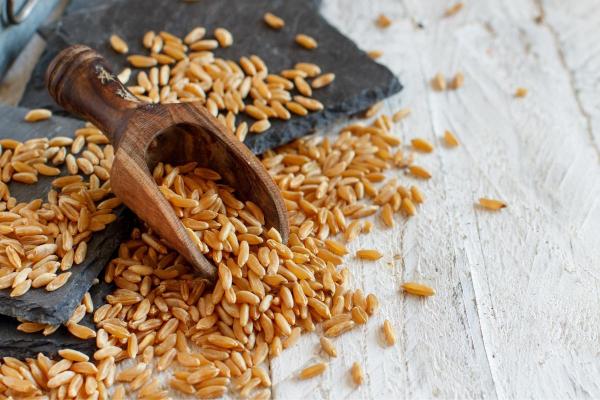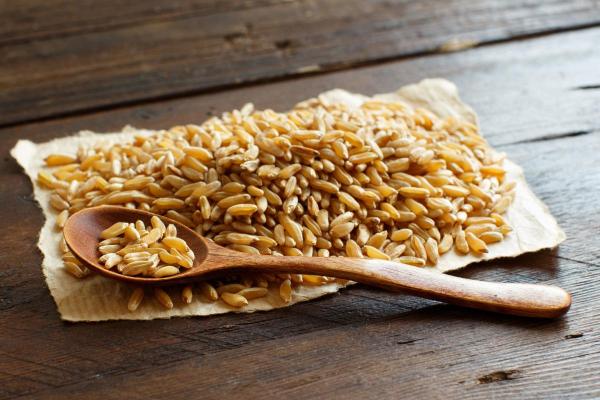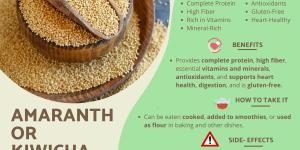What Is Kamut? - Khorasan Wheat Properties


Also known as Oriental or Khorasan wheat, Kamut is an ancient cereal whose origin is still uncertain. It stands out for its large golden grains which are larger than most other wheat varieties. Its properties include high protein, mineral and vitamin content. This powerful grain has nutritional and antioxidant properties that provide numerous nutritional benefits when eaten as part of a balanced diet. When eaten correctly, it can help improve cardiovascular health and digestive transit, as well as reduce oxidative stress and provide energy, among many other benefits.
At thedailyECO, we learn more by asking what is Kamut? We look at the properties and benefits of Khorasan wheat to see if this is a food you might want to include in your diet.
What is Kamut or Khorasan wheat?
Kamut is the commercial trade name for Khorasan or Oriental wheat, also known as simply Khorasan. It is an ancient variety of unmodified, non-hybridized wheat grain. It has gained recent popularity due to its nutritional qualities. All wheat sold under the Kamut trademark has to meet the quality requirements demanded by the brand.
This cereal belongs to the subspecies Triticum turgidum subsp. turanicum. This is a subspecies of durum wheat, the wheat grain often used to make pasta. Although its origin is still a matter of debate, it is believed to come from the ancient Khorasan region that included much of northeastern Iran in Afghanistan and Central Asia. It is from this region the general name of Kamut is derived.
Kamut is characterized by its large grains. They are two or three times larger than most other wheats. It is amber color and has glassy sheen. It is distinguished from other varieties by its nutritional composition, since it contains a greater amount of proteins, minerals, vitamins, lipids and amino acids. Despite these boosted properties and benefits of Khurasan wheat, it can be used in a similar way to other types of wheat. Most often, this it is used as Kamut flour.

Kamut properties
While we know that Khorasan flour and other products has nutritional benefits, it can be helpful to look at the nutritional composition of Kamut in more detail:
- Nutritional: Kamut contains between 15-20% protein. Additionally, it is a good source of minerals such as selenium, zinc, magnesium and phosphorus. These are essential minerals for various bodily functions, including the immune system and bone health. It also contains B vitamins such as thiamine (B1) and niacin (B3), important for metabolism and the functioning of the nervous system. It also has omega-3 and omega-6 fatty acids in a balanced ratio, which favors cardiovascular health.
- Antioxidants: Kamut has been found to have antioxidant activity primarily due to its selenium and vitamin E content, which helps fight oxidative stress and protects cells from damage.
Benefits of Kamut
The nutritional composition of Khorasan wheat can provide various benefits for those who want to eat a healthy diet. They include:
- It has a high nutritional value: Kamut is an excellent source of proteins, minerals and essential vitamins for the body, which makes it a nutrient-rich food.
- Contributes to the proper functioning of the digestive system: its fiber content favors digestion and reduces problems such as constipation.
- Improves cardiovascular health: fatty acids such as omega-3 present in Kamut help maintain a healthy heart and reduce the risk of cardiovascular diseases.
- Blood sugar stabilization: due to its low glycemic index, Kamut can help maintain stable blood sugar levels.
- Reduces oxidative stress: the antioxidants present in Khorasan wheat fight free radicals and oxidative stress, thus protecting cells from damage.
- Stimulates the nervous system: the B vitamins in Kamut are important for the proper functioning of the nervous system, which can improve brain health.
- Stimulates the immune system: Kamut contains minerals such as zinc and selenium which strengthen the body's defenses against various pathogens and other microbial issues.
- Provides energy: being a food rich in carbohydrates, it works as a constant energy supply, improving physical and mental performance throughout the day.
Although Khorasan wheat offers numerous nutritional benefits, it should be consumed as part of a balanced and varied diet. Always consult a healthcare professional before making significant changes to your diet, especially if you have food allergies or intolerances. If eating Kamut for weight loss, appropriate levels of exercise are also required.

How to use Kamut
Khorasan wheat is a versatile grain with a mild nutty flavor that can be used in a similar way to other types of wheat. Although its grains can be eaten directly , it is commonly ground down to produce Kamut flour.
Whether using Khorasan flour or in other preparations, you can make the following food items with Kamut:
- Breads
- Pasta
- Pizza
- Cookies
- Cakes
- Drinks
Khorasan can also be used as a substitute for other grains such as quinoa or bulgur wheat. For this reason, it is also a good addition to salads, soups, stews and many other dishes.
If you would like to try this type of cereal, you can buy it using the following link:

Kamut contraindications
Although Kamut is a very healthy grain for many people, this does not mean Khorasan wheat is good for everybody. In the following cases, Kamut should not be included in the diet:
- Celiac disease or allergies to gluten: although there are rumors that Khorasan wheat may be better tolerated by people with celiac disease than other types of wheat, Kamut does contain gluten. It is therefore not considered a food suitable for people who suffer from these pathologies.
- Wheat allergy: some people may have allergies specifically to wheat, including Kamut. Wheat allergy symptoms can include itching, swelling, difficulty breathing and rashes. In such cases, its consumption should be avoided.
- Excessive consumption: as with any food, excessive consumption of Kamut could cause digestive problems. It is always important to maintain a varied diet.
Now that you know about the benefits and properties of Kamut, you may want to know more about eating healthily. You can do so with our articles on the differences between organic and natural food, as well as what are the types of cross contamination in food.
If you want to read similar articles to What Is Kamut? - Khorasan Wheat Properties, we recommend you visit our Healthy foods category.
- Kamut brand wheat. Retrieved from: https://www.kamut.com/








